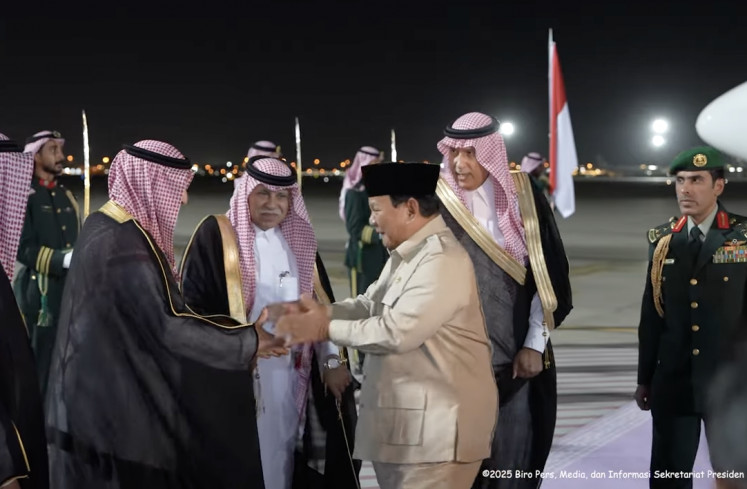Popular Reads
Top Results
Can't find what you're looking for?
View all search resultsPopular Reads
Top Results
Can't find what you're looking for?
View all search resultsIndonesian Diaspora 2012: Time to embrace marriage migrants
The Congress of the Indonesian Diaspora (CID) is just around the corner
Change text size
Gift Premium Articles
to Anyone

T
he Congress of the Indonesian Diaspora (CID) is just around the corner. Indonesians living overseas are excited for this rare event that some believe is comparable to the 1928 Sumpah Pemuda (Youth Pledge) — intended to unite those who associate themselves with Indonesia as well as to renew a pledge of nationalism among overseas Indonesians.
CID will give hope, as well, to a certain group that has long been ignored: marriage migrants.
Marriage migrants are Indonesian citizens who have married foreign nationals and migrated to their spouse’s countries. Marriage migration can be felt, especially with the growing usage of virtual social networks where these relationships are often initiated, but cannot be seen because of the absence of data.
For example, Indonesia’s national report at the annual migration conference of the Asia-Pacific Migration Research Network-UNESCO (APMRN) gives a brief descriptive paragraph of the phenomenon without data, compared to labor migration, which was thoroughly reported with statistics.
Why does marriage migration remain invisible in Indonesia? Is the government not interested in following this type of mobility because participants have potentially abandoned their Indonesian citizenship?
In my opinion, whether or not they eventually become citizens of other countries as result of their marriage, they should not be neglected in this way. As Anand Krishna previously wrote in this daily, being an
Indonesian means more than having a passport; it is an identity that no one can remove.
As an example of this, compare the marriage records between Indonesia and the US in 2007 and 2008. The Office of Religious Affairs recorded only one of 243 total mixed-marriages performed at the institution in 2007 and two marriages from 161 mixed-marriages in 2008.
In contrast, the US Department of Homeland Security Yearbook states that about 125 out of 316 Indonesian women with spousal admissions were admitted in 2007 as fiancées to be married in the US within 90 days and, in 2008, the number of women was 143 out of 357. This indicates that about 40 percent of Indonesian-American marriages were conducted abroad.
According to a survey I conducted of Indonesian women in mixed marriages, 111 of 181 participants recorded their marriage both in Indonesia and in their spouse’s country.
Fifty respondents that married abroad never recorded their marriage in Indonesia and 20 respondents also married abroad conducted a nikah siri (unregistered marriage) prior to migration.
About 40 percent of marriage migrants never recorded their marriage with officials. When asked about the reason for not recording their marriages in Indonesia, the women’s responses varied from technical obstacles to a lack of pre-and post-migration information.
In addition, the physical presence requirement to report the marriage to the Vital Statistics Office in Indonesia and the associated cost of travelling were major obstacles. Itsbat nikah, an overseas report for those who conducted nikah siri, requires the presence of both spouses.
According to survey respondents, Indonesian government representatives are not prepared to serve in this function and often use the excuse that they are “waiting for the procedure from Jakarta”.
Other respondents admitted that they were not informed about how to benefit from reporting the marriage. The relationship between the Indonesian government and marriage migrants is clearly not well connected.
Because identifying the diaspora community helps capitalize Indonesian identities abroad for the benefit of the country, the CID provides a good opportunity to bring the issue to the table and improve arrangements for marriage migration.
Marriage migrants should not be considered part of the “brain drain” phenomenon, but as active agents in maintaining cultural circulation through various activities.
For example, a marriage migrant was voted as one of the Most Influential Asian Americans in the US state of Georgia; another acts as facilitator of an Indonesian cultural center’s activities in the US, France, and Germany. Anggun C Sasmi, an Indonesian who represented France in the recent Eurovision 2012 singing contest, is not alone.
Reza is a Swedish Idol and Rosalina and Nining participated on “The Voice” in Holland and Denmark. Their Indonesian heritage is undeniable; yet, according to the Indonesian government, Indonesian women like them that live all over the world are deniable.
Let’s change this by bringing attention to the “invisibility” of marriage migrants at the upcoming Congress of the Indonesian Diaspora.
The writer is one of the coordinators for Komunitas Kawin Campur, a network of 3,400 Indonesian marriage migrants living all over the world. She is a PhD candidate in Global Gender Studies at the State University of New York, Buffalo.









